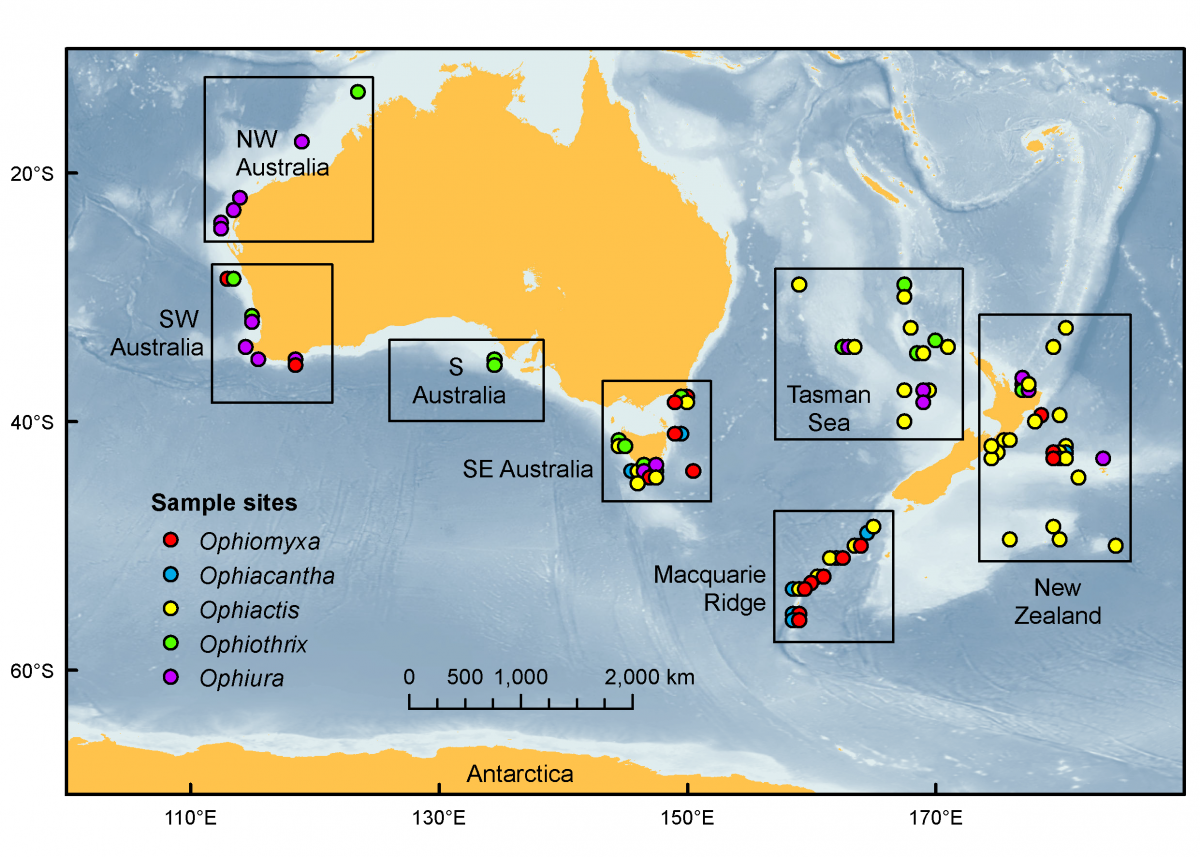April 29, 2014
NERP Marine Biodiversity Hub scientists have been charting the rollercoaster rides of brittle-stars (ophiuroids) in a first step towards the detailed mapping of deep-seabed connectivity.
The team of CSIRO geneticists, led by Dr Tim O’Hara of Museum Victoria, examined 562 mitochondrial DNA sequences from specimens of five bathyal brittle-star species collected between south-western Australia and New Zealand (at depths of 200–3,500 metres).
Connectivity science looks at the movement of larvae or adults to see how biological populations are related. It is applicable to biodiversity conservation and fisheries management.
Connectivity data can be used to find key source and sink areas, and natural areas of exchange. In turn, this information can be used to identify natural management units, to target critical areas for protection, and to develop monitoring strategies.
For example, a seabed community or site that is a sink for larvae is likely to be able to rebuild after being damaged, but is unlikely to meaningfully contribute to the maintenance of diversity elsewhere. In contrast, a community that is a source of larvae is likely to be ecologically important, but may not rehabilitate well.
Stars are models
Tim says that brittle-stars are useful model organisms for connectivity studies because they are abundant, occupy a range of habitats, and have a variety of dispersal strategies.
‘Importantly, we were looking at deep-sea species: large-scale studies of this kind have been limited due to the logistical challenges.
‘We were fortunate that Australian, New Zealand and French (New Caledonian) expeditions proceeded concurrently (2000–2010) giving us access to many specimens.
‘This presented an opportunity to test whether bathyal animals (particularly brooding megafauna, like some of the brittle-stars) can disperse across the wide, deep (4,000–5,000 m) abyssal plain between Australia and New Zealand.
‘We were looking to see if we could detect larval dispersal routes from the patterns of genetic structure in adults.’
Populations span the abyss
The study found that five ophiuroid species commonly found on the upper continental slope (200–2,000 m) showed little genetic structure over thousands of kilometres.
This suggests that these animals can disperse over long distances, including across the abyssal plain, which is far too deep to support populations of these animals.
So how do the brittle-stars disperse?
Do they use volcanic seamounts as ‘stepping stones’? Do they ride deep super gyre currents across the Southern, Indian and Pacific oceans? Do their reproductive strategies play a role?
Two reproductive tactics
While further molecular and life history data are required to unravel the dispersal processes of these interesting animals, the reproductive antics of one particular species raises tantalising possibilities.
This is the brittle-star Ophiacantha vivipara, which inhabits seamounts around Tasmania, on the Chatham rise and the Macquarie Ridge, south of New Zealand.
‘Many deep-water ophiuroids have a yolky kind of larvae that is hypothesised to be able to travel long distances by being neutrally buoyant and minimising metabolic requirements,’ Tim says. ‘A few have feeding larvae that presumably rise to surface waters to feed before sinking to settle on the seafloor.
‘Typically, one would expect brooders (such as isopods and amphipods) to show different patterns, but one of our animals, (O. vivipara), was a brooder, and this also showed little genetic structure, suggesting that it, too, can disperse over long distances.
‘This is surprising as it was unclear how a brooding animal could spread over the inhospitable abyssal plain between seamount chains. The answer is perhaps that this species can disperse in two ways. We hypothesise that it releases some eggs for long distance dispersal, and broods others to build up local populations.’
Are ophiuroids typical?
Because so few studies of this sort have been done over large spatial scales, it is impossible to say whether the patterns shown in ophiuroids are typical of other deep-sea taxa.
Tim says that future work with many genetic markers will have greater power to map detailed larval dispersal patterns. This work will be assisted by detailed physical connectivity models being developed by the Marine Hub. Understanding how species are connected in the deep sea helps to contextualise the assessment of impacts associated with extraction activities in this low energy environment.
The deep sea environment, including seafloor features such as seamounts and canyons, are represented in Commonwealth Marine Reserves. The deep sea environment is becoming increasingly explored for oil and gas development and deep seabed mining.
Further reading
- T.D. O'Hara; P.R. England; R.M. Gunasekera; K.M. Naughton. Limited phylogeographic structure for five bathyal ophiuroids at continental scales Deep Sea Research (2014)
-
Connectivity symposium for marine managers at AMSA conference - ‘Using marine connectivity information to address management issues’, will be held at the 51st Australian Marine Sciences Association conference to be held at Canberra in July 2014. http://www.amsaconference.com.au/
The symposium will introduce marine managers to the value of connectivity science, and elucidate the types of products that they consider most useful.
More info: Johnathan Kool, Geoscience Australia, johnathan.kool@ga.gov.au
Images
Thumbnail - Ophiacantha vivpara. Image: Tim O'Hara, Museum Victoria
Map of sample sites and analysis regions for the five species complexes, Ophiuroids - see journal article above. Image: Tim O'Hara, Museum Victoria

Contact:
Tim O’Hara, Museum Victoria
- Log in to post comments
